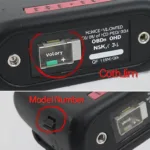The Chevrolet Tahoe transitioned from OBD1 to OBD2 in the 1996 model year. This shift, mandated by the Environmental Protection Agency (EPA), marked a significant change in how vehicle emissions and diagnostics were handled. Understanding this transition is essential for anyone working with or owning a Tahoe.
Understanding the OBD1 to OBD2 Shift in Chevrolet Tahoes
The change from OBD1 to OBD2 wasn’t just about a different connector under the dash. It represented a leap forward in automotive technology, introducing standardized diagnostic capabilities and more stringent emission controls. Before 1996, Tahoes used the OBD1 system, which varied significantly between manufacturers and even between models. This made diagnostics challenging, requiring specialized equipment for each vehicle. The introduction of OBD2 standardized the diagnostic process, making it easier to identify and address issues related to emissions and engine performance.
Why the Change to OBD2?
The primary driver behind the shift to OBD2 was environmental concern. OBD2 systems are more sophisticated in monitoring and controlling emissions, leading to cleaner air. The standardized diagnostic interface also made it easier for technicians to identify and repair emission-related problems, further contributing to cleaner air. Beyond environmental benefits, OBD2 offered improvements in vehicle maintenance and diagnostics, simplifying troubleshooting for both professionals and DIY enthusiasts.
What Year Did the Tahoe Make the Switch?
As mentioned earlier, the 1996 model year marked the transition for the Chevrolet Tahoe from OBD1 to OBD2. This applies to all Tahoe models produced from 1996 onwards. If you own a Tahoe from 1995 or earlier, it will have an OBD1 system. Knowing your Tahoe’s model year is crucial for selecting the correct diagnostic tools and understanding its emissions system.
Key Differences Between OBD1 and OBD2 in Chevrolet Tahoes
The differences between OBD1 and OBD2 in Tahoes are significant, impacting diagnostics, emissions control, and overall vehicle maintenance.
-
Standardization: OBD2 introduced a standardized diagnostic connector and protocol, simplifying diagnostics across all vehicle makes and models. OBD1, on the other hand, lacked this standardization, making it more complex to diagnose issues.
-
Diagnostic Capabilities: OBD2 systems provide more detailed diagnostic information, including real-time data on various engine parameters. This enhanced data allows for more precise diagnostics and targeted repairs. OBD1 offered limited diagnostic capabilities compared to OBD2.
-
Emissions Monitoring: OBD2 systems have more advanced emission monitoring capabilities, tracking a wider range of parameters and flagging issues more effectively. This contributes to better emissions control and reduced environmental impact.
How to Determine Your Tahoe’s OBD System
The easiest way to determine if your Tahoe has OBD1 or OBD2 is to check the model year. 1996 and later models have OBD2. Another method is to look under the dash for the diagnostic connector. The OBD2 connector is a 16-pin trapezoidal connector, while OBD1 connectors vary in shape and pin configuration.
“Knowing the difference between OBD1 and OBD2 is crucial for any Tahoe owner. It allows for more effective troubleshooting and ensures you’re using the right diagnostic tools,” says Michael Johnson, Automotive Diagnostics Expert at CarTech Solutions.
Benefits of OBD2 in Chevrolet Tahoes
The adoption of OBD2 brought several advantages to Chevrolet Tahoe owners, including simplified diagnostics, improved emissions control, and enhanced maintenance capabilities.
-
Easier Diagnostics: The standardized OBD2 system simplifies the diagnostic process, making it easier for technicians and DIYers to identify and address vehicle issues.
-
Improved Emissions Control: The more sophisticated monitoring and control capabilities of OBD2 contribute to lower emissions and reduced environmental impact.
-
Enhanced Maintenance: OBD2 provides valuable data for preventative maintenance, allowing owners to address potential issues before they become major problems.
Conclusion
The shift from OBD1 to OBD2 in the 1996 Chevrolet Tahoe marked a significant advancement in automotive technology, bringing standardized diagnostics, improved emissions control, and enhanced maintenance capabilities. Understanding this transition is crucial for anyone working with or owning a Tahoe, enabling effective troubleshooting and informed maintenance decisions. If you’re unsure about your Tahoe’s OBD system, checking the model year or locating the diagnostic connector can provide a quick answer. Knowing your Tahoe’s OBD system is the first step towards efficient diagnostics and maintaining your vehicle’s optimal performance.
FAQ
- What is OBD? On-Board Diagnostics (OBD) is a system that monitors and reports on various vehicle systems, primarily related to emissions.
- What’s the difference between OBD1 and OBD2? OBD2 is a standardized system, while OBD1 varied between manufacturers. OBD2 also offers more advanced diagnostics and emissions monitoring.
- How can I tell if my Tahoe has OBD1 or OBD2? Check the model year (1996 and later are OBD2) or locate the diagnostic connector under the dash.
- Why is it important to know my Tahoe’s OBD system? Knowing the OBD system ensures you use the correct diagnostic tools and understand the vehicle’s emissions system.
- Where is the OBD2 connector located in a Tahoe? It’s typically located under the dash, near the steering column.
- What can an OBD2 scanner tell me? It can provide diagnostic trouble codes (DTCs), real-time data on engine parameters, and other valuable information about the vehicle’s systems.
- Can I use an OBD1 scanner on an OBD2 Tahoe? No, you need an OBD2 scanner for a 1996 or later Tahoe.
Need more help? Contact us via WhatsApp: +1(641)206-8880, Email: [email protected] or visit us at 789 Elm Street, San Francisco, CA 94102, USA. We offer 24/7 customer support. You can also explore our other articles on OBD2 scanners and vehicle diagnostics on our website.
